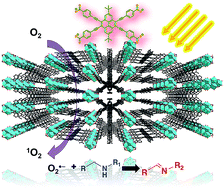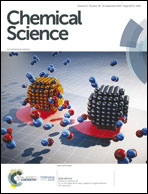Visible-light harvesting pyrene-based MOFs as efficient ROS generators†
Abstract
The utilization of reactive oxygen species (ROS) in organic transformations is of great interest due to their superior oxidative abilities under mild conditions. Recently, metal–organic frameworks (MOFs) have been developed as photosensitizers to transfer molecular oxygen to ROS for photochemical synthesis. However, visible-light responsive MOFs for oxygen activation remains scarce. Now we design and synthesize two porous MOFs, namely, PCN-822(M) (M = Zr, Hf), which are constructed by a 4,5,9,10-(K-region) substituted pyrene-based ligand, 4,4′,4′′,4′′′-((2,7-di-tert-butylpyrene-4,5,9,10-tetrayl)tetrakis(ethyne-2,1-diyl))-tetrabenzoate (BPETB4−). With the extended π-conjugated pyrene moieties isolated on the struts, the derived MOFs are highly responsive to visible light, possessing a broad-band adsorption from 225–650 nm. As a result, the MOFs can be applied as efficient ROS generators under visible-light irradiation, and the hafnium-based MOF, PCN-822(Hf), can promote the oxidation of amines to imines by activating molecular oxygen via synergistic photo-induced energy and charge transfer.



 Please wait while we load your content...
Please wait while we load your content...